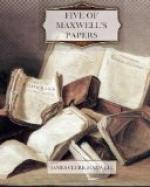When we mix together blue and yellow paint, we obtain green paint. This fact is well known to all who have handled colours; and it is universally admitted that blue and yellow make green. Red, yellow, and blue, being the primary colours among painters, green is regarded as a secondary colour, arising from the mixture of blue and yellow. Newton, however, found that the green of the spectrum was not the same thing as the mixture of two colours of the spectrum, for such a mixture could be separated by the prism, while the green of the spectrum resisted further decomposition. But still it was believed that yellow and blue would make a green, though not that of the spectrum. As far as I am aware, the first experiment on the subject is that of M. Plateau, who, before 1819, made a disc with alternate sectors of prussian blue and gamboge, and observed that, when spinning, the resultant tint was not green, but a neutral gray, inclining sometimes to yellow or blue, but never to green. Prof. J. D. Forbes of Edinburgh made similar experiments in 1849, with the same result. Prof. Helmholtz of Konigsberg, to whom we owe the most complete investigation on visible colour, has given the true explanation of this phenomenon. The result of mixing two coloured powders is not by any means the same as mixing the beams of light which flow from each separately. In the latter case we receive all the light which comes either from the one powder or the other. In the former, much of the light coming from one powder falls on particles of the other, and we receive only that portion which has escaped absorption by one or other. Thus the light coming from a mixture of blue and yellow powder, consists partly of light coming directly from blue particles or yellow particles, and partly of light acted on by both blue and yellow particles. This latter light is green, since the blue stops the red, yellow, and orange, and the yellow stops the blue and violet. I have made experiments on the mixture of blue and yellow light—by rapid rotation, by combined reflexion and transmission, by viewing them out of focus, in stripes, at a great distance, by throwing the colours of the spectrum on a screen, and by receiving them into the eye directly; and I have arranged a portable apparatus by which any one may see the result of this or any other mixture of the colours of the spectrum. In all these cases blue and yellow do not make green. I have also made experiments on the mixture of coloured powders. Those which I used principally were “mineral blue” (from copper) and “chrome-yellow.” Other blue and yellow pigments gave curious results, but it was more difficult to make the mixtures, and the greens were less uniform in tint. The mixtures of these colours were made by weight, and were painted on discs of paper, which were afterwards treated in the manner described in my paper “On Colour as perceived by the Eye,” in the Transactions of the Royal Society of Edinburgh, Vol. XXI. Part 2. The visible effect of the colour is estimated in terms of the standard-coloured papers:—vermilion (V), ultramarine (U), and emerald-green (E). The accuracy of the results, and their significance, can be best understood by referring to the paper before mentioned. I shall denote mineral blue by B, and chrome-yellow by Y; and B3 Y5 means a mixture of three parts blue and five parts yellow.




